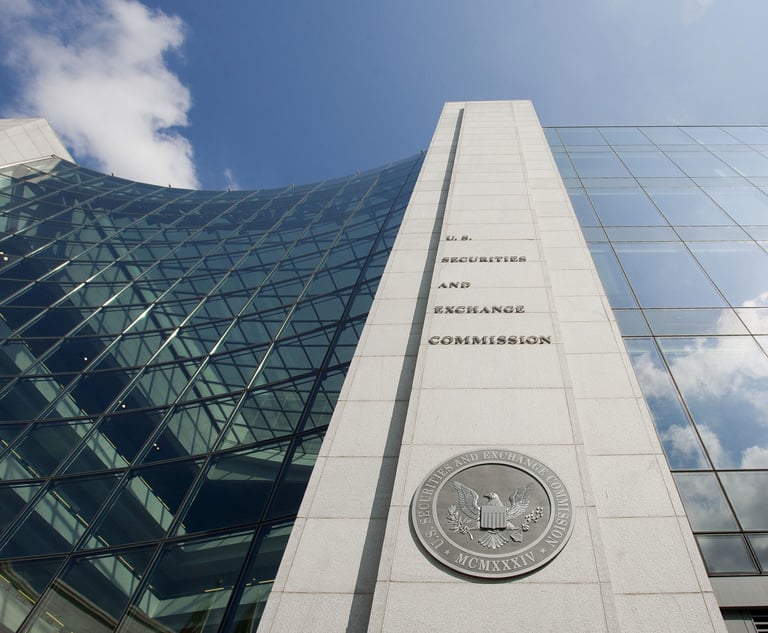Compliance Clarity
Commission offers new guidelines to curb abuses in the energy industry.
July 31, 2008 at 08:00 PM
6 minute read
Given the way the federal bureaucracy often works, it's not surprising that businesses regulated by the Federal Energy Regulatory Commission (FERC) have been clamoring for more compliance guidance since the Energy Policy Act of 2005 expanded FERC's enforcement authority.
The Act allowed FERC to impose civil penalties of $1 million per day for energy market abuse. But what is surprising is that the commission–with the release of its enforcement package May 15–has responded promptly and to the general satisfaction of its constituents.
“FERC held a conference in 2007 at which the industry pointed out some very specific compliance problems,” says Susan Olenchuk, an energy lawyer at Van Ness Feldman. “The commission obviously took it all to heart and is definitely trying to provide the industry with what it requested.”
FERC is an independent agency that regulates the interstate transmission of electricity, natural gas and oil. It has enforcement authority under the Federal Power Act, the Natural Gas Act and the Natural Gas Policy Act.
In 2005, the Energy Policy Act expanded FERC's market power and enforcement jurisdiction. Supporting competitive energy markets and preventing market manipulation became two of the agency's top priorities, meaning that almost anyone who buys or sells energy became subject to its jurisdiction.
The enforcement package seeks to improve the investigative process by making it more transparent, clarifying the rights of those being investigated and establishing measures to ensure that FERC employees treat respondents fairly. It also goes a long way toward helping companies avoid being targets of investigations by providing guidance for the content of compliance plans.
“FERC has made an earnest effort to help the industry understand what the standard for compliance is going to be,” Olenchuk says. But that's the bright side.
Taking Action
The dark side is that the very release of the enforcement package means that FERC's enforcement division is hitting full stride.
“The announcement of the enforcement package means FERC will likely increase the number of enforcement actions it brings and that the penalties sought will be more severe,” says Jeffrey Ansley, a former FERC prosecutor and now a partner at Bracewell & Giuliani.
Regardless, it's clear that the path of enforcement will be a much better-marked route than it has been to date. “The commission has given substantially more guidance about the factors that will lead to a recommendation for a public investigation,” Ansley says.
To that end, the package identifies 11 aspects of a company's filings that FERC will examine during the nonpublic investigation that precedes the formal public investigation. They include the nature, seriousness and prevalence of the occurrence; whether any violation can be remedied; the likelihood of recurrence; and the company's compliance history.
FERC has also expanded the rights of respondents by allowing them to communicate in writing directly with the commissioners at any time during a nonpublic investigation. Staff must notify respondents if they intend to recommend a public investigation to the commissioners, and at that point, respondents have another 30 days to submit a response in writing. The recommendations and response are then submitted to commissioners simultaneously.
“This procedure presents an opportunity for companies to lay out a detailed legal and factual statement as to why the commissioners should take no action or limited action,” Ansley says. “This right to be heard is a very positive development.”
Clear Instructions
Some observers, however, believe that targets should have the right to communicate their concerns orally–a right that is neither granted nor curtailed under existing procedures.
“FERC is clamping down on its willingness to entertain oral communications during ongoing nonpublic investigations, and there's a real concern that merely filing written communications in what are invariably complex cases does not provide targets with an adequate opportunity to be heard,” Olenchuk says.
Still, no one denies that the added clarity is a step in the right direction.
“What is so helpful is that the guidance is more explicit on what needs to be done at what point in the process,” says Sheila Hollis, formerly FERC's first director of enforcement and now a partner at Duane Morris. “It's always helpful to know what is supposed to happen next because it makes for a better opportunity to spell out one's position.”
And to the commission's credit, the enforcement package's approach to process is consistent throughout, even after FERC conducts a public investigation and concludes that a civil penalty is in order.
In this scenario, the package helps respondents by prioritizing the factors that FERC will take into account in deciding on the extent of the penalty it will impose.
“The two most important categories are the seriousness of the offense and the strength of the company's commitment to compliance,” Olenchuk says. “FERC also will consider whether the company self-reported the violation, demonstrated exemplary cooperation and relied on prior FERC staff guidance.”
As significant as the changes to the enforcement procedure, however, is the guidance outside the context of enforcement proceedings. For the most part, this relates to the “no-action letter” (NAL) process.
Consensus Control
The NAL process allows companies to get staff's written views on whether a particular transaction, practice or situation would be subject to enforcement action.
Although NAL responses do not bind the commission, both the Office of the General Counsel and the Office of Enforcement sign them, which means they reflect a consensus view. Because the commission solicits the views of its Office of Energy Market Regulation where appropriate, NALs often reflect this division's views as well.
Until now, FERC has limited the NAL process' application to several narrowly defined issues, such as the commission's market behavior and energy manipulation rules.
Under the new regime, NALs are available for all matters under FERC's jurisdiction but for a few specific exceptions relating to hydroelectric projects, certification of natural gas pipelines, operation of LNG terminals and enforcement of mandatory reliability standards.
What it all amounts to, then, is more flesh on the bones for FERC's constituency.
“Dealing with FERC is no longer a leap off the diving board without knowing whether there's water below,” Hollis says.
This content has been archived. It is available through our partners, LexisNexis® and Bloomberg Law.
To view this content, please continue to their sites.
Not a Lexis Subscriber?
Subscribe Now
Not a Bloomberg Law Subscriber?
Subscribe Now
NOT FOR REPRINT
© 2025 ALM Global, LLC, All Rights Reserved. Request academic re-use from www.copyright.com. All other uses, submit a request to [email protected]. For more information visit Asset & Logo Licensing.
You Might Like
View All
Khan Defends FTC Tenure, Does Not Address Post-Inauguration Plans

Best Practices for Adopting and Adapting to AI: Mitigating Risk in Light of Increasing Regulatory and Shareholder Scrutiny
7 minute read
Crypto Groups Sue IRS Over Decentralized Finance Reporting Rule

SEC Penalizes Wells Fargo, LPL Financial $900,000 Each for Inaccurate Trading Data
Trending Stories
- 1Courts, Lawyers Press On With Business as SoCal Wildfires Rage
- 2Florida, a Political Epicenter, Is the Site of Brownstein Hyatt's 13th Office
- 3Law Firms Close Southern California Offices Amid Devastating Wildfires
- 4Lawsuit alleges racial and gender discrimination led to an Air Force contractor's death at California airfield
- 5Holland & Knight Picks Up 8 Private Wealth Lawyers in Los Angeles
Who Got The Work
Michael G. Bongiorno, Andrew Scott Dulberg and Elizabeth E. Driscoll from Wilmer Cutler Pickering Hale and Dorr have stepped in to represent Symbotic Inc., an A.I.-enabled technology platform that focuses on increasing supply chain efficiency, and other defendants in a pending shareholder derivative lawsuit. The case, filed Oct. 2 in Massachusetts District Court by the Brown Law Firm on behalf of Stephen Austen, accuses certain officers and directors of misleading investors in regard to Symbotic's potential for margin growth by failing to disclose that the company was not equipped to timely deploy its systems or manage expenses through project delays. The case, assigned to U.S. District Judge Nathaniel M. Gorton, is 1:24-cv-12522, Austen v. Cohen et al.
Who Got The Work
Edmund Polubinski and Marie Killmond of Davis Polk & Wardwell have entered appearances for data platform software development company MongoDB and other defendants in a pending shareholder derivative lawsuit. The action, filed Oct. 7 in New York Southern District Court by the Brown Law Firm, accuses the company's directors and/or officers of falsely expressing confidence in the company’s restructuring of its sales incentive plan and downplaying the severity of decreases in its upfront commitments. The case is 1:24-cv-07594, Roy v. Ittycheria et al.
Who Got The Work
Amy O. Bruchs and Kurt F. Ellison of Michael Best & Friedrich have entered appearances for Epic Systems Corp. in a pending employment discrimination lawsuit. The suit was filed Sept. 7 in Wisconsin Western District Court by Levine Eisberner LLC and Siri & Glimstad on behalf of a project manager who claims that he was wrongfully terminated after applying for a religious exemption to the defendant's COVID-19 vaccine mandate. The case, assigned to U.S. Magistrate Judge Anita Marie Boor, is 3:24-cv-00630, Secker, Nathan v. Epic Systems Corporation.
Who Got The Work
David X. Sullivan, Thomas J. Finn and Gregory A. Hall from McCarter & English have entered appearances for Sunrun Installation Services in a pending civil rights lawsuit. The complaint was filed Sept. 4 in Connecticut District Court by attorney Robert M. Berke on behalf of former employee George Edward Steins, who was arrested and charged with employing an unregistered home improvement salesperson. The complaint alleges that had Sunrun informed the Connecticut Department of Consumer Protection that the plaintiff's employment had ended in 2017 and that he no longer held Sunrun's home improvement contractor license, he would not have been hit with charges, which were dismissed in May 2024. The case, assigned to U.S. District Judge Jeffrey A. Meyer, is 3:24-cv-01423, Steins v. Sunrun, Inc. et al.
Who Got The Work
Greenberg Traurig shareholder Joshua L. Raskin has entered an appearance for boohoo.com UK Ltd. in a pending patent infringement lawsuit. The suit, filed Sept. 3 in Texas Eastern District Court by Rozier Hardt McDonough on behalf of Alto Dynamics, asserts five patents related to an online shopping platform. The case, assigned to U.S. District Judge Rodney Gilstrap, is 2:24-cv-00719, Alto Dynamics, LLC v. boohoo.com UK Limited.
Featured Firms
Law Offices of Gary Martin Hays & Associates, P.C.
(470) 294-1674
Law Offices of Mark E. Salomone
(857) 444-6468
Smith & Hassler
(713) 739-1250






